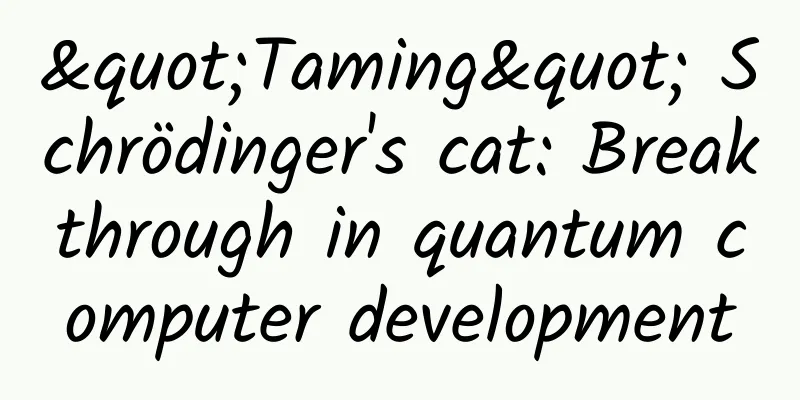"Taming" Schrödinger's cat: Breakthrough in quantum computer development

|
Physicists at the University of Sussex have tamed one of the most counter-intuitive phenomena in modern science, taking a crucial step towards a new generation of computers that will revolutionize the way we solve many modern scientific problems. Physicists often use a thought experiment to illustrate the mysterious and strange nature of quantum mechanics: Schrödinger's cat. In theory, Schrödinger's cat can be dead and alive at the same time. Physicists at the University of Sussex have used new technology to successfully construct a special type of 'Schrödinger's cat' based on the trapping of ions and microwave radiation, according to a paper published this week in the journal Bulletin of Physics A. Like cats, the researchers created an “entangled state” in which the ions exist in two states at once. This effect challenges reality itself. These trapped ions could lead scientists toward a new class of machines that could tap into the power of quantum physics to solve problems with incredible efficiency. Traditionally, scientists have used lasers to power this quantum process, but millions of stable laser beams must be carefully manipulated to coordinate with an equally large number of ions to construct valuable data. However, it would be much easier to build a quantum computer if microwave radiation was used instead of lasers. This is like a microwave oven in your kitchen, which uses mature and reliable technology and emits radiation that can be easily spread over a large space. Researchers at the University of Sussex have used microwave radiation instead of lasers to create ions in a ‘Schrödinger’s cat’ state, an important step towards the prospect of realising quantum computers. Dr Winfried Hensinger, lead scientist at the Sussex research group, said: "It remains a huge challenge to build a large-scale quantum computer, but this achievement shows that we are making progress from the basic science towards a breakthrough technology that has the potential to change our lives." Dr. Heisinger's research group, which includes two postdoctoral fellows and three doctoral students, spent two years developing this microwave radiation-based technology, which could greatly simplify the path to quantum computing. "This achievement opens up completely new possibilities for realizing new quantum technologies," said Dr. Seb Weidt, one of the postdoctoral researchers in the research group. As a winner of Toutiao's Qingyun Plan and Baijiahao's Bai+ Plan, the 2019 Baidu Digital Author of the Year, the Baijiahao's Most Popular Author in the Technology Field, the 2019 Sogou Technology and Culture Author, and the 2021 Baijiahao Quarterly Influential Creator, he has won many awards, including the 2013 Sohu Best Industry Media Person, the 2015 China New Media Entrepreneurship Competition Beijing Third Place, the 2015 Guangmang Experience Award, the 2015 China New Media Entrepreneurship Competition Finals Third Place, and the 2018 Baidu Dynamic Annual Powerful Celebrity. |
<<: Counterpoint: Tesla's deliveries in Q4 2023 will increase by 20% year-on-year
Recommend
360 search advertising promotion daily budget modification settings!
What is a daily budget? The daily budget is the m...
Tencent Advertising Guide for the Dental Industry
1. Oral Industry Research 1. Overview of the dent...
How does live streaming make you addicted to shopping?
At the beginning of 2020, the COVID-19 outbreak g...
The history of the hot money war in China: Huge profits in the top hot money battlefield, A-share hot money biography series PDF
[Hunan Tough Guy] History of the Hot Money War in...
Is it reliable to use hot water to scald tableware?
Friends, is there anyone around? Do you like to s...
How to quickly acquire seed users and detonate product potential?
In the Internet age, the efficiency of informatio...
How long can eroticism, horror and bad taste sustain online movies?
On July 13, the online movie "The Scarecrow&...
Guide to saving your life at the beach: It looks safe, but you can be killed if you are not careful!
It is so refreshing to go to the beach to play in...
How does Tik Tok make you addicted?
The world of short videos has never been peaceful...
China Passenger Car Association: From January to September 2022, the wholesale volume of new energy passenger vehicles reached 4.341 million units, a year-on-year increase of 115.4%
The China Passenger Car Association released an a...
BAIC New Energy obtains listing approval with fundraising of no more than 2 billion yuan
On June 1, the China Securities Regulatory Commis...
I always feel like I'm going to be "yang", what should I do?
Recently, a new "unknown disease" - &qu...
Mineral water, purified water, boiled water...what are the differences between these different types of water?
What is the difference between purified water and...
What does it mean to dominate the screen with ten thousand words? How to understand the phrase "Ten Thousand Words Dominating the Screen"?
After the New Year’s Day in 2020, someone called ...
Operational notes from Tencent PM: 3 major skills for product operation
Making TO C products is like playing with buildin...



![[Qiu Ming Stock Talk] Wen Qiu Ming's Band Master Practical Class](/upload/images/67cc10f2b1b13.webp)





